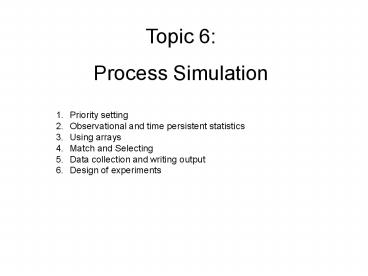Process Simulation - PowerPoint PPT Presentation
1 / 37
Title:
Process Simulation
Description:
Data collection and writing output. Design of experiments ... Data Collection Period 5. Replication 5. Transient. Replication 1. Transient. DCP 1. DCP 2 ... – PowerPoint PPT presentation
Number of Views:72
Avg rating:3.0/5.0
Title: Process Simulation
1
Topic 6 Process Simulation
- Priority setting
- Observational and time persistent statistics
- Using arrays
- Match and Selecting
- Data collection and writing output
- Design of experiments
2
(No Transcript)
3
Observational versus Time Persistent Statistic
What is the average inventory level?
Inventory Level (XX1)
0 10 20 30 40
50 60 70
Time (Tnow)
Observational Statistic if we count inventory
as each job completes First job leaves at
Tnow50, inventory level 3 Second job leaves
at Tnow55, inventory level 2 Third job leaves
at Tnow70, inventory level 1
6/32 Time Persistent Statistic 0-100(10)0 40
-503(10)30 10-201(10)10 50-552(5)10 20-40
2(20)40 55-701(15) 105/701.5
4
(No Transcript)
5
ARRAY,1,5,0.0,0.0,12.9,3.0,5.0 ARRAY,3,3,12.8,7
.0,0.0 ARRAY,10,8,0.0,0.0,0.0,0.0,0.0,9.0,7.5,2.
0
Control Statements
Establish a data storage area
ARRAY 1 ARRAY 3 ARRAY 10
That may be used in the network
Expon(array(1,3))
Atribarray(1,4)expon(3) Atrib(2)array(10,6)50
Array(atrib2,4)xx11
1
Expon(array(1,5))
Atrib1
1
Array(3,2)
Customer_traits
6
(No Transcript)
7
(No Transcript)
8
The MATCH Node
Input Option Default MVAL Matching
atrib error WFM Node label
Connector
9
(No Transcript)
10
Input Option Default QSR Queue selection
rule ORDER SSR Server selection rule ORDER
The SELECT Node
11
(No Transcript)
12
(No Transcript)
13
(No Transcript)
14
(No Transcript)
15
The WRITE Node
Input Option Default FILE Output file
name error FLUSH Flush Parameter NO YES
flush output after WRITE NO flush after run
completes FORMAT Output format of string
standard c character s - string of
characters d - signed decimal integer f -
floating point \f - form feed \n - new
line \r-carriage return M Maximum emanating
activities infinity
16
(No Transcript)
17
(No Transcript)
18
Design of Experiments, Verification, and
Validation Of Simulation Models
19
(No Transcript)
20
Replication 1
Data Collection Period 1
Transient
Replication 2
Data Collection Period 2
Transient
Replication 3
Data Collection Period 3
Transient
Replication 4
Data Collection Period 4
Transient
Replication 5
Data Collection Period 5
Transient
21
Replication 1
Transient
DCP 1
DCP 2
DCP 3
DCP 4
DCP 5
22
Example do you see any autocorrelation in the
following series?
Average of 16 values
N1 9 obs above average N2 7 obs below
average r 7 runs
23
Too few runs at a.05
N2 3 4 5 6 7 8 9 10 N1 3 2 2 2 2 2 4 2 2
2 3 3 3 5 2 2 3 3 3 3 3 6 2 2 3 3 3 3 4 4 7 2 2
3 3 3 4 4 5 8 2 3 3 3 4 4 5 5 9 2 3 3 4 4 5 5 5 10
2 3 3 4 5 5 5 6
Too many runs at a.05
N2 3 4 5 6 7 8 9 10 N1 3 4 9 9 5 9 10 10
11 11 6 9 10 11 12 12 13 13 7 11 12 13 13 14 14
8 11 12 13 14 14 15 9 13 14 14 15 16 10 1
3 14 15 16 16
24
(No Transcript)
25
(No Transcript)
26
(No Transcript)
27
(No Transcript)
28
(No Transcript)
29
.05/3.01667 Experimentwise error
30
(No Transcript)
31
(No Transcript)
32
.05/4.0125 Experimentwise error
33
(No Transcript)
34
Verification Does the model perform as intended?
Debug in modules Use lots of eyes Use a wide
variety of input settings make sure output is
reasonable Run a trace Start with a small model
and build up Animation can add transparency
35
Validation Does the model accurately reflect the
system under study
State simulation hypothesis first (and
often) High face validity talk with the system
experts Keep the model as small as
possible Keep a log Contrast simulation
behavior with actual system behavior
36
Contrast simulation behavior with actual system
behavior
37
Contrast Example
Simulation Using Real System Inputs
Simulation Using Random Inputs
Real System
2.99 2.40
3.68 2.81
2.59 1.32
-0.69 0.45
0.40 2.73
Mean Std dev































